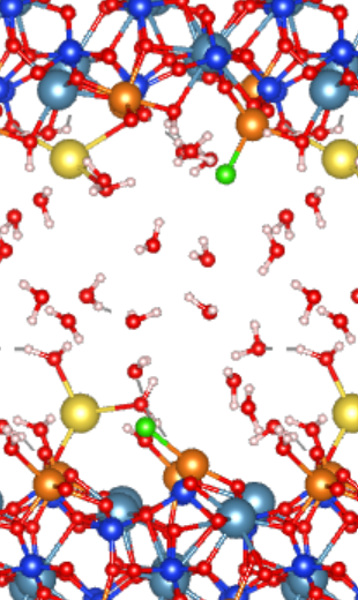MLMD: On‑the‑Fly MLFFs for Diopside–Water Interfaces
This study focuses on developing machine learning force fields (MLFFs) for diopside–water interfaces using VASP’s on‑the‑fly machine learning approach. The goal is to enable quantum-level accuracy for complex silicate–water systems at a fraction of the computational cost of full ab initio molecular dynamics (AIMD).
Background: Why combine DFT and MLFFs
DFT calculations are invaluable for understanding atomic-scale interactions because they provide quantum-level accuracy for adsorption energetics, charge transfer, and reaction pathways. However, DFT is computationally expensive, limiting simulations to short timescales and small system sizes. VASP’s on-the-fly machine learning force fields (MLFFs) overcome this limitation by learning from DFT data during simulations, enabling long-timescale molecular dynamics with near-DFT accuracy. This approach allows us to capture dynamic processes such as ion exchange, surface restructuring, and the influence of salinity or dissolved carbon species under realistic geochemical conditions—insights that would be impractical to obtain using DFT alone. By combining the rigor of DFT with the efficiency of MLFFs, we achieve predictive modelling that bridges atomic-scale chemistry and macroscopic mineral carbonation processes.
Systems Studied
- Diopside/water
- Diopside/water/NaF
- Diopside/water/NaCl
- Diopside/water/carbonic acid

Approach
- Training – on-the-fly learning ensured continuous improvement of MLFFs during simulations
- Validation – structural and energetic properties validated against DFT throughout and after the learning process
- Realism – enables simulations of realistic geochemical conditions (salinity, carbon species)
- Provides – dynamic processes and predictive capability for silicate-water systems without sacrificing quantum-level accuracy

Key Findings
-
High accuracy: The MLFFs closely match DFT-level precision while being computationally much faster.
-
Efficiency: The on-the-fly training significantly reduces the need for extensive precomputed datasets.
-
This method enables large-scale, long-timescale simulations of mineral-water systems that were previously too computationally expensive.
-
It opens up new possibilities for studying reactive transport, mineral dissolution, and environmental remediation processes.
